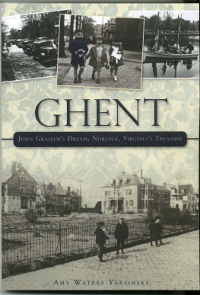Ghent is more that just a pretty place,” wrote Norfolk Compass writer Mary Adams-lackey in April of 1990, as Ghent turned a century old. “Shaped by her creators, her abusers and those who finally rescued her, Ghent is a gritty Southern belle.” Ghent, perhaps more than any other Norfolk suburb, has a story to tell that transcends its historic port city lineage, reaching national importance in its planning and execution.
Get your copy at Amazon, Barnes & Noble, Prince Books (available in the store) and the Publisher
That this “gritty Southern belle” remains is a testament to her good genes. The people who populated Ghent during its early years generally rebuilt the city of Norfolk after the American Civil War; they reconstructed the trade on which much of the city’s power and influence still rests, and were instrumental in transforming Norfolk from a regional to a national city during the prosperous years between the Civil War and the end of the World War I. This was a great accomplishment requiring a concerted team effort. The team lived in Ghent-and what a team it was, its legacy extending long after those whose collective achievements have passed into time and memory.
Ghent today provides intimate in-town living within walking distance of Norfolk’s commercial heart. Gone are the spectacular trees planted by William H White; the silver maples and magnolias that originally graced Ghent’s street have long since vanished from the landscape, replaced by large oaks. The Trinidad asphaltum blocks have been paved over with asphalt, and the historic, steel-riveted bridge replaced in 1976 and since refurbished to enhance its pedestrian features. Despite changing times and tastes, Ghent’s period architecture, tree-lined streets and attractive waterfront location combine to ensure that Ghent will remain a beloved, integral area of Norfolk for generations.
ISBN 9781540204400, Arcadia Publishing; Copyright (C) Amy Waters Yarsinske 2023
Enjoy Amy’s other treasured books on Norfolk: Winter Comes to Norfolk, Ocean View, Norfolk’s Church Street, Lost Norfolk, and the book that started it all – Norfolk, Virginia – the Sunrise City by the Sea
